586 Knickerbocker Road, Cresskill NJ 07626
(201) 568-2823
Procedures
Preventive Dentistry
What is Periodontal Disease?
Periodontal (gum) disease is an infection. It affects the tissues and bone that support the teeth. Healthy gum tissue fits like a cuff around each tooth. When someone has periodontal disease, the gum tissue pulls away from the tooth. As the disease gets worse, the tissue and bone that support the tooth are damaged. Over time, teeth may fall out or need to be removed. Treating periodontal disease in the early stages can help prevent tooth loss.
Periodontal Disease and Whole-Body Health
Periodontal disease has been linked to some other diseases. People with diabetes or heart disease are more likely to get periodontal disease. Strokes and high stress also may be related to periodontal disease. Researchers are still studying these links.
Warning Signs of Gum Disease
If you notice any of the signs below, see your dentist. However, you can have periodontal disease and not notice any of these warning signs. That is why regular dental checkups are very important.
- Gums that bleed when you brush or floss
- Red, swollen, or tender gums
- Gums that have pulled away from your teeth
- Bad breath that doesn’t go away
- Pus between the teeth and gums
- Loose or separating teeth
- A change in the way your teeth fit together when you bite
- A change in the fit of partial dentures
What Causes Periodontal Disease?
Periodontal disease is caused by plaque, a sticky film that is always forming on your teeth. Plaque contains bacteria that can irritate and inflame the gums.
Inflamed gums can pull away from the teeth and form spaces called “pockets.” These pockets collect more bacteria. If the infected pockets are not treated, the gum disease can get worse.
Sealants
Our teeth are covered with a sticky film of bacteria, called plaque (sounds like PLAK). When we eat or drink anything that contains sugar-such as cookies, candy, soda, juice, or sports drinks-bacteria turn the sugar into acids that can attack tooth enamel. Over time, these attacks may cause tooth decay, or cavities. The good news is that there is a way to protect teeth and prevent decay: dental sealants.
Why are sealants needed?
Tooth decay often begins on the chewing surfaces of the back teeth. These surfaces have pits and grooves that trap plaque, bacteria, and bits of food. The pits and grooves are hard to keep clean, because toothbrush bristles cannot reach into them.
That is how decay starts in the pits and grooves and cavities form. To keep decay from starting here, the dentist may recommend dental sealants.
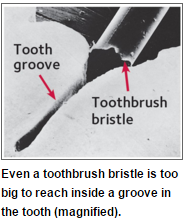
How do sealants work?
A dental sealant is a plastic material (resin) applied to the chewing surfaces of the back teeth. The sealant material flows into the pits and grooves in the teeth. The sealant acts as a barrier, protecting enamel by sealing out plaque, bacteria, and food.
How are sealants applied?
Sealants are easy to apply. It takes only a few minutes to seal each tooth. First, the tooth is cleaned and the chewing surfaces are prepared to help the sealant stick to the tooth. Then the sealant is painted onto the chewing surface where it bonds to the tooth and hardens. A special light may be used to help the sealant harden. Sealants are generally clear or white and cannot be seen when you smile or talk.

How long do sealants last?
Sealants usually last several years before they need to be replaced. Over time, sealants can become loose or worn. Then they may not protect the teeth as well. Chewing on ice or hard foods can also break down sealants. During regular dental visits, your dentist will check your sealants and reapply them if needed.
How else can I protect teeth from decay?
Sealants protect only the chewing surfaces of teeth. To prevent cavities, follow these Healthy Smile Tips:
- Brush your teeth twice a day with a fluoride toothpaste.
- Clean between your teeth once a day.
- Eat a healthy diet and limit snacks.
- Visit your dentist regularly.
These good habits stop decay from forming in between the teeth-spots that sealants cannot cover.
Look for oral care products that display the ADA Seal of Acceptance. This tells you that the product meets ADA standards for safety and effectiveness.
Who should get sealants?
Sealants are most often placed in children and teenagers, since tooth decay can start soon after teeth come in. But adults can sometimes benefit from sealants too, because you never outgrow the risk for developing cavities.
A sealant can be placed on a tooth that does not have a cavity in its pits and grooves. If a tooth is stained or has mild decay, your dentist may suggest you get a sealant, or another option may be necessary. If a tooth has more advanced decay, it will need a filling.
Prevention is always better than treatment. Sealants are very useful in preventing tooth decay on the back teeth and can save patients money over time. Your dentist can make sealants part of your plan for a healthy mouth.
General Dentistry
General Dentistry is the practice of preventing, diagnosing and correcting dental issues. We perform all general dental services to keep you healthy and smiling.
Why You Should See Your Dentist?
When you visit the dentist, you get more than clean, shiny teeth. Regular dental visits are a way to prevent dental disease and to check for signs of other diseases. If your mouth or neck do show any signs of disease, your dentist can help you get early treatment. Here’s how.
You can stop tooth decay from getting worse
- Your dentist will check for tooth decay and treat it if needed.
- Untreated tooth decay can lead to pain, loss of confidence and tooth loss.
Tooth Decay
Some people think only children get tooth decay, but all of us are at risk our whole lives. The good news is that tooth decay can be prevented. By following a healthy oral care routine and making smart food choices, you can lower your risk for tooth decay.
What is tooth decay?
Tooth decay is a disease that damages and breaks down teeth. A tooth has a hard outer layer (enamel), a middle layer (dentin) and a center (pulp). The more layers affected by decay, the worse the damage.
Diagram of a Healthy Tooth
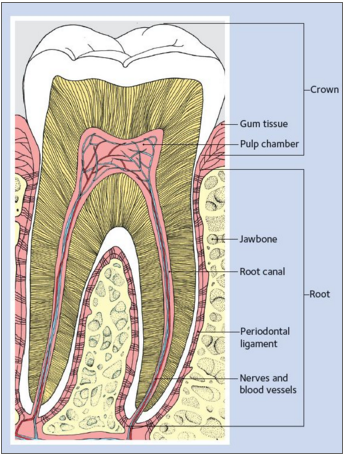
If tooth decay is not treated, it can lead to pain, the spread of infection, loss of teeth and loss of self-confidence. People with tooth pain often cannot eat or sleep properly and may miss days of work or school. And tooth decay is not only unhealthy, it also looks bad.
An abscess (pus-filled sac) from a cavity can cause serious or even life-threatening infections when not properly treated. It is much simpler and more affordable to prevent tooth decay than to repair or replace a decayed tooth.
What causes tooth decay?
Your teeth are covered by a sticky film of bacteria called plaque (sounds like PLAK). After a meal or snack, the bacteria turn the sugars in foods and drinks into acid. The acid attacks the tooth enamel.
When you have sugary foods or drinks many times a day, or if you sip on the same sugary drink for long periods of time, the acid attacks your tooth enamel again and again. The acid eats away at the tooth and can cause decay. A hole called a cavity can form.
Progress of Tooth Decay


Who gets tooth decay?
People of all ages can get tooth decay. Your risk may increase if you:
- often snack and sip on sugary foods and drinks
- have a dry mouth from medicines or for other reasons
- have weak enamel due to genetics or a childhood illness
- don’t brush twice daily with a fluoride toothpaste
Can tooth decay be passed from person to person?
No, but the bacteria that cause tooth decay can be shared. Bacteria can be passed from one mouth to another by kissing, sharing a cup or spoon, or anything else that carries a drop of saliva.
Can tooth decay be prevented?
Yes. Here’s how:
- Brush your teeth twice a day with a fluoride toothpaste.
- Avoid frequent sipping and snacking on sugary drinks and foods.
- Drink water that has fluoride.
- Visit your dentist regularly for an exam and a professional teeth cleaning.
- Ask your dentist if dental sealants are right for you or your children.
Your saliva helps prevent tooth decay, too. It reduces acid damage to a tooth by washing away sticky, sugary foods. Saliva also makes the acid weaker. Chewing sugarless gum after eating can increase saliva flow and help rinse away sugars. The minerals in saliva also can help repair the tooth.
When choosing dental care products, look for those that show the American Dental Association’s Seal of Acceptance. The Seal of Acceptance tells you that, when used as directed, the product meets the ADA’s standards for safety and effectiveness.
Common places where decay forms
Tooth decay can damage any tooth. It often occurs between the teeth and in the grooves of the back teeth, where bits of food collect. Back teeth are harder to keep clean because they are not as easy to reach. Also, toothbrush bristles cannot get into the grooves. Decay also can form at the tooth root and go below the gumline.
Common Places for Decay
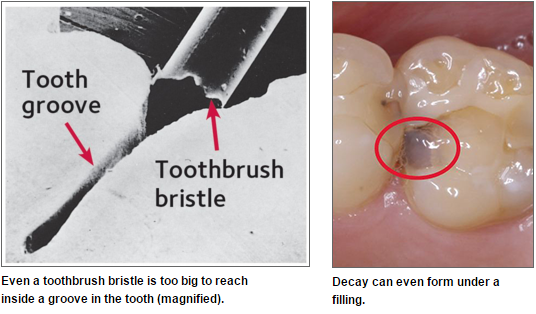
Do you have tooth decay?
Symptoms of tooth decay can include spots on the teeth, bad breath and loose fillings. Tell your dentist if your teeth are sensitive to heat or cold or if you have any tooth pain. Your dentist will examine your teeth and take X-rays if needed.
How is decay treated?
Treatment depends on how early the decay is caught. Before cavities form, fluoride treatments may solve the problem. If you have a cavity, you’ll need a filling. A large cavity may need a crown to replace the decayed part of the tooth. If the center (pulp) of your tooth is involved, root canal treatment may be your last chance to save the tooth. Finally, a badly damaged tooth might have to be pulled and replaced. Your dentist will discuss options and plan the best way to get your mouth healthy again.
Almost half of adults over 30 have gum disease
- It may not hurt, and you may not even know you have it until it becomes a big problem. Gum disease is a main cause of tooth loss.
- See your dentist if you notice any changes in your mouth, such as gums that are red, swollen or tender or that bleed when you brush or floss. Your dentist can tell you if you have gum disease. He or she can also help you get your gums healthy again.
Have whiter teeth and fresher breath
- You may be missing a few areas when you brush and floss at home.
- At your dental visit, a dentist or hygienist will clean your teeth to remove surface stains and any tartar buildup. He or she will also give you tips for cleaning your teeth and tongue at home.
- Professional dental cleanings also help prevent gum disease.
For mouth and throat cancer screenings
- Mouth and throat cancer are deadly diseases. Almost 4 in 10 patients diagnosed with these cancers will die within five years.
- Your dentist checks your mouth and neck for signs of cancer every time you visit. Cancers that are found early can lead to better outcomes.
The mouth can show if the body is not healthy
- Diseases that affect the entire body (such as diabetes) may first be noticed because of mouth sores, gum disease or other oral problems. Your dentist is trained to notice these symptoms.
- Your dentist will keep your general health in mind when planning your oral treatment. He or she may refer you to a physician if needed.
Even patients with dentures need an oral health checkup. Plus, over time, dentures can become loose because of changes in your gums and bones. Your dentist will make sure your gums are healthy, look for signs of cancer and check your dentures for proper fit.
At every exam, your dentist checks your mouth and neck for signs of disease. Your oral health is an important part of your overall health, so visit your dentist regularly.
Crowns
What is a crown?
A crown is a cover or “cap” your dentist can put on a tooth. The crown restores the tooth to its normal shape, size and function. The purpose of a crown is to make the tooth stronger or improve the way it looks.
Why do I need a crown?
You may need a crown if you:
- Have a cavity that is too large for a filling
- Have a missing tooth and need a bridge
- Need to cover a dental implant
- Have a tooth that is cracked, worn down or otherwise weakened
- Have had root canal treatment-the crown will protect the restored tooth
- want to cover a discolored or badly shaped tooth and improve your smile!
Crown Used to Replace a Filling
What is it made from?
Crowns are made from several types of materials. Metal alloys, ceramics, porcelain, composite resin, or combinations of these materials may be used. In the process of making a crown, the material often is colored to blend in with your natural teeth.

Your dentist wants to create a crown that looks natural and fits comfortably in your mouth. To decide on the material for your crown, your dentist will consider the tooth location, the position of the gum tissue, the patient’s preference, the amount of tooth that shows when you smile, the color or shade of the tooth, and the function of the tooth.
How is a crown placed?
Several steps are involved, and two dental visits are generally needed to complete the treatment.
- The dentist prepares the tooth by removing its outer portion so the crown will fit. Any decay is also removed. If additional tooth structure is needed to support the crown, the dentist may build up the core of the tooth.
- An impression is made to provide an exact model for the crown.
- You will get a temporary crown while you wait for the permanent crown to be ready-usually less than two weeks. While you have the temporary crown, this tooth may be sensitive to hot and cold. Also, avoid chewing gum or sticky foods during this time.
- The dentist or a laboratory technician then uses the model to help make the crown.
- When the new crown is ready, the dentist places it in your mouth and makes the necessary adjustments. When you and your dentist are satisfied with how it looks and feels, the crown is cemented in place.
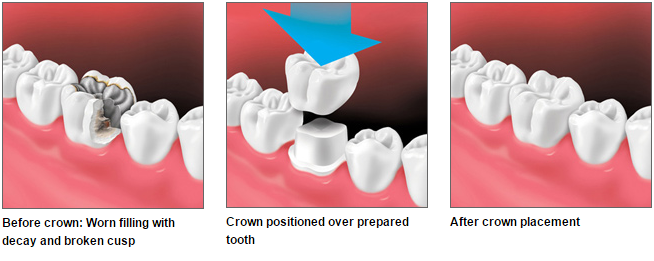
Caring for your teeth
To prevent damage to a crown, there are a few things you can do:
- Brush twice a day and floss once a day to remove plaque, a sticky film of bacteria. Look for oral care products that have the ADA Seal of Acceptance. Products that display the Seal have met the American Dental Association’s standards for safety and effectiveness.
- Avoid chewing hard foods, ice or other hard objects, such as pencils. This is especially important for tooth-colored crowns.
- Be sure to see your dentist for regular exams and professional teeth cleanings.
Bridges
What is a Bridge?
A bridge is a dental restoration that fills the space where one or more teeth are missing. The bridge restores your bite and helps keep the natural shape of your face. Before you get a bridge, your dentist wants you to know more about the steps involved. He or she can advise which type of bridge is best for you.
Why Do I Need a Bridge?
A missing tooth is a serious matter. Teeth are made to work together. When you lose a tooth, the nearby teeth may tilt or drift into the empty space. The teeth in the opposite jaw may also shift up or down toward the space. This can affect your bite and place more stress on your teeth and jaw joints, possibly causing pain.
Teeth that have tipped or drifted are also harder to clean. This puts them at a higher risk for tooth decay and gum disease. When a tooth is missing, the bone may shrink. If that happens, it may change the way the jawbone supports the lips and cheeks. Over time, this can make your face look different.
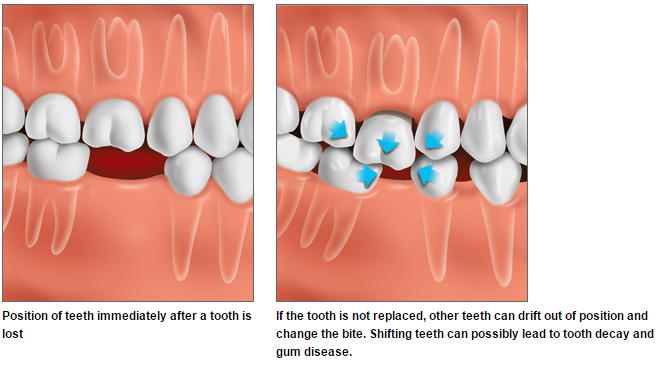
How is a Bridge Placed?
Placing a bridge usually takes more than one dental visit. On your first visit, your dentist prepares the teeth on either side of the gap. The bridge will later be attached to these teeth. When talking about bridges, your dentist may use these terms:
- Pontic: the replacement for your missing tooth
- Crown: a “cap” that covers the attachment tooth
Your dentist then takes an impression of your teeth and the space and sends the impression to a dental laboratory. Technicians at the lab make the bridge. Your dentist will place a temporary bridge to protect your exposed teeth while you are waiting for the permanent one.
The bridge is then fixed, or cemented, to the prepared teeth. This type of bridge is permanent and cannot be taken out of your mouth without a dentist’s help. During one or more follow-up visits, the bridge is fitted, adjusted and cemented in place.
Bridge Placement
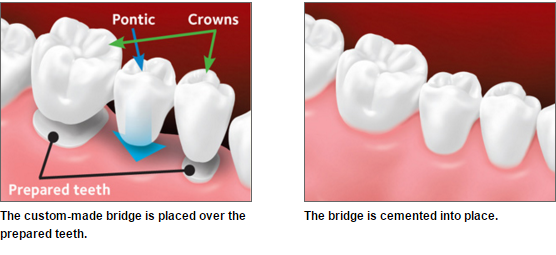
Do I Need Implants?
Dental implants may be used to support a bridge when several teeth are missing. Implants are posts that are surgically placed into the jaw. The implants fuse to the jawbone to act as a base for the bridge. A key benefit of implants is that they don’t need support from the surrounding teeth.
Because surgery is required, candidates for dental implants should have good general health and enough bone to support an implant. For some patients, implants help preserve the bone where teeth have been lost. Implants can be placed in one day or may require multiple visits, depending on your dentist’s treatment plan for you.
Implant-Supported Bridge
What Materials Are Used in a Bridge?
Bridges are made from metal, ceramics or a combination. Ceramics often are bonded to a metal alloy. Your dentist will talk about the materials that are best for you and your mouth.
Caring for Your Bridge
A bridge can lose its support if the surrounding teeth or jawbone holding the bridge are damaged by dental disease. Follow these tips for good oral health:
- Brush twice a day and floss or use another between-the-teeth cleaner. Brushing and cleaning between the teeth helps remove plaque, a sticky film containing bacteria. Always clean between your teeth and under the bridge. There are many kinds of flossers, picks or little brushes-ask your dentist what type will work well with your bridge.
- See your dentist regularly for exams and professional cleanings.
- Eat a balanced diet for good health.
- Look for oral care products that have the ADA Seal of Acceptance. Products that display the Seal have met the American Dental Association’s standards for safety and effectiveness.
Cosmetic Dentistry
Today, cosmetic dentistry is more popular than ever, from whitening and shaping to closing spaces and replacing teeth. We offer a wide array of services and techniques for improving the look of your smile. Our goal is to make your smile better and more beautiful than ever.

Improving your Smile
Smile Checklist
Look in the mirror
- Do you like the way your teeth look?
- Do you dislike the color of any of your teeth?
- Are there spaces between your teeth?
- Do you have any chips or cracks on your teeth?
- Are you missing any teeth?
- Do you have any crooked teeth?
- Do you feel your teeth are too long or too short?
- Are you pleased with the shapes and position of your teeth?
If your answers show that you might want a change in your smile, talk to your dentist about Improving Your Smile. A great smile can be the most attractive feature of your face.
A smile helps you express health, success, youth and sincerity. It is a great asset in your personal, business and social contacts. So it’s important that you are happy with how your smile looks. But if you are like many people, you may not be.
Your dentist has many different techniques to shape, sculpt, and make your smile more beautiful. With a few simple steps, you can have a smile you feel great about. And treatment may be more affordable than you think.
Options for improving your smile include:
Tooth-Colored Fillings
Your dentist can use natural-colored materials to restore teeth that have cavities. Options include composite materials, such as resin, as well as lab-made porcelain inlays, inlays and crowns.
Tooth Whitening
Teeth become stained for many reasons – drinking coffee, tea or wine; smoking; and even aging can discolor teeth. Tooth whitening is a process that makes discolored teeth whiter. The bleach used for in-office (chair side) whitening is stronger than the bleach found in at-home whitening kits. Keep in mind that not everyone’s teeth can become movie-star white. Your dentist can recommend the whitening treatment that is right for you.
Veneers
Veneers are thin, tooth-colored shells that are bonded, or cemented, to the front of your teeth. They are custom-made of ceramic or composite resin, and look like natural teeth. Veneers can be used to fill spaces between teeth and to cover teeth that are stained, poorly shaped, or a bit crooked.
Braces
Braces can help correct crowded or crooked teeth or an uneven bite. Braces have become much smaller and less noticeable over the years. Brackets, the part of the braces that attach to each tooth, can sometimes be attached to the back of the tooth to make them less noticeable. Some brackets are clear or tooth coloured-which help braces blend in.
In some cases, treatment may be done without using braces at all. A series of clear, removable aligners are used to move your teeth over time. These aligners are more discreet than traditional braces.
Enamel Shaping
Your dentist can “reshape” your teeth by contouring tooth enamel, the outer layer of the tooth. When teeth are a little crowded or uneven, or when teeth appear too long, your dentist can use enamel shaping to improve how the teeth look.
Crowns
If a tooth needs more a dramatic change than veneers or enamel shaping can provide, crowns are an option. The outer part of the tooth is removed and a crown is placed over it. The crown can be made to fit in with your other teeth. It’s like a fresh start for your tooth.
First Steps to a New Smile
Once you decide to improve your smile, the first step is to visit your dentist. At this visit, you will talk about the best plan for you. If you have any signs of dental disease, your dentist may recommend treatment for this. It’s important to have a healthy mouth before starting cosmetic treatment.
These treatments and others can help you have more natural-looking and attractive teeth. What are you waiting for? Talk to your dentist today about how to make your smile the best it can be.
Dental Implants
Dental implants are an effective way to replace missing teeth. When teeth are lost because of disease or an accident, dental implants may be a good option. You may want to choose dental implants if you:
- Hide your smile because you have missing teeth
- Wear dentures that are uncomfortable
- Are dissatisfied with your removable partial dentures
- Want to keep your other teeth intact
Many people choose implants to replace a single tooth or several teeth, or to support a full set of dentures. Implants are posts surgically placed into the upper or lower jawbone. They replace the root of one or more missing teeth.
Dental implants are made of titanium (a strong, lightweight metal) and other materials that are well accepted by the body. More than 5 million implants are placed each year by dentists in the United States.
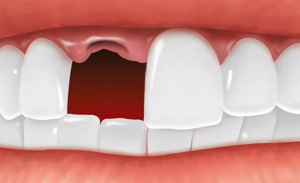
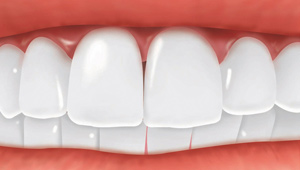
Benefits of Dental Implants
- Implants offer firm support to man-made teeth. Dentures, bridges or single teeth attached to the implants won’t slip or shift in your mouth-a very important benefit when eating and speaking.
- This secure fit also helps man-made teeth feel more natural than typical bridges or dentures.
- Some people may find implant-supported dentures more comfortable than dentures that do not use implants.
- Where teeth are missing, dental implants also help keep the jawbone from shrinking.
- Implants are a good value, because they can last a lifetime with good care.
Single Tooth Implants
The single tooth implant replaces the missing tooth’s roots. A single tooth implant is a stand-alone unit and does not involve treating the teeth next to it.


If you are missing one or more teeth, there are many reasons why you should replace them:
- You may not like how the gap looks when you smile.
- Missing teeth may affect how you speak.
- A missing molar tooth can make it harder to chew.
- When a tooth is lost and not replaced, the teeth around it can shift.
- Bone loss can occur around the missing tooth. This may cause the remaining teeth to become loose over time.
- Loss of teeth and bone can make your face sag. You may look older.
Implant-Supported Bridges and Dentures
Dental implants can be used to support a bridge when several teeth are missing. The implant-supported bridge replaces the lost natural teeth and some of the tooth roots. Unlike traditional bridges, an implant-supported bridge does not need support from the teeth next to it.
If you are missing all of your teeth, an implant-supported denture can replace the missing teeth and some of the tooth roots. Because the dental implants integrate (or “fuse”) with the jawbone, an implant-supported denture tends to be comfortable and stable, allowing you to bite and chew naturally.
Implant-Supported Denture Before
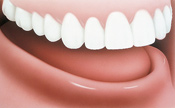

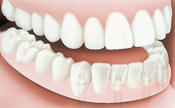
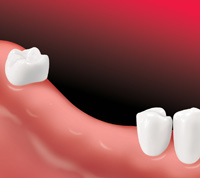
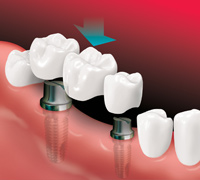

What Is Involved in Implant Placement?
Many kinds of implants are available. Treatment can take only one day, or it can take several months, or somewhere in between. Your dentist and you can discuss which type of implant is best for you.
Implant treatment usually involves three basic steps:
• Placement of the Implant
Your dentist will carefully locate where the implant should be placed, using x-rays or other pictures. Then the dentist surgically places the implant into the jawbone. You may have some swelling and/or tenderness after surgery. Your dentist may prescribe pain medicine to ease the discomfort. During the healing process, your dentist may tell you to eat soft foods.
• Healing Process
What makes an implant so strong is that the jawbone grows around it and holds it in place. This process, called osseointegration (OSS-e-o-in-te-GRAY-shun), takes time. It may be several months before the implant is completely integrated into the bone. Then the patient can get the permanent replacement tooth or teeth. In many cases, the implant and temporary replacement teeth can be placed in one visit.
• Placement of the Prosthesis (Replacement Tooth or Teeth)
For a single tooth implant, the dentist custom-makes a new tooth for you, called a dental crown. It is designed to look just like your other teeth. Implant-supported bridges and dentures are also custom-made to look like natural teeth and to fit your mouth. The replacement teeth are attached to the implant posts.
Replacement teeth usually take some time to make. In the meantime, your dentist may give you a temporary crown, bridge or denture. This will help you eat and speak normally until the permanent replacement teeth are ready.
Who Is a Good Candidate for Dental Implants?
If you are in good general health and your jaw can support an implant, this treatment may be a good option for you. Your health is more important than your age.
However, implants are not an option for everyone. Patients should be in good health or cleared by their physicians before scheduling any implant surgery. They should have enough jawbone to support the implant or be able to have surgery to build up the jawbone. Bone can be built up with a bone graft or with sinus lift surgery. Chronic illnesses, such as diabetes and leukemia, may slow healing after surgery.
Implant treatment may not be a good option for patients with these illnesses. Tobacco use also can slow the healing process.
If your dentist does recommend implant treatment, careful oral hygiene is essential for the success of the implant. You must spend time caring for the implant and making sure the area around it is very clean. If not, you might increase your risk for gum disease, which can weaken the bone and tissues needed to support the implant.
Other Things to Think About
You should discuss implant treatment carefully with your dentist. Dental implant treatment can take longer and cost more than other replacement options. But dental implants are often a good value because they can last a lifetime.
Regular dental visits are key to the long-term success of your implant. Your dentist will set up a program to help you keep your implant and natural teeth healthy. Your dentist also will suggest a home-care routine that meets your needs. It will include brushing twice a day and flossing once a day. You also may be advised to use a special toothbrush or mouth-rinse to help prevent cavities and gum disease.
Talk with your dentist about dental implants. He or she can help you decide if implant treatment is right for you. With careful treatment planning and good oral care, dental implants can provide a healthy smile for a lifetime.
Periodontal Treatment
Periodontal treatments depend on the type of the gum disease and how severe it is. If the disease is caught early (when it is gingivitis), and no damage has been done to the supporting structures under the teeth, you may simply need a professional cleaning. The dental team can give you tips for improving your daily oral hygiene.
Even with these measures, some patients develop more severe periodontal disease. The first step in treating the disease usually involves a special deep cleaning called “scaling and root planing.” In this treatment, the dentist removes plaque and tartar down to the bottom of each periodontal pocket. This treatment may be done over several visits, depending on your needs.
The root surfaces of the teeth are then smoothed (or “planed”) to allow the gum tissue to heal and reattach to the teeth. This treatment also may take more than one visit.
Your dentist may recommend medications to help control infection and pain or to aid healing. These can include a pill, a mouthrinse or a medication that the dentist places directly into the periodontal pocket after scaling and root planing.
If you smoke or chew tobacco, it is important to quit. Ask your dentist or physician for information about ways to stop.
Another dental visit will be scheduled within a few weeks or months after your last scaling and root planing treatment. At this visit, your dentist or hygienist will look at your gums to see how they have healed. He or she will measure the periodontal pockets again. If the pockets have gotten deeper and the supporting bone is lost, more treatment may be needed.

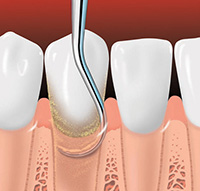
Periodontal Surgery
If the pockets do not heal enough after scaling and root planing, periodontal surgery may be needed. Surgery allows the dentist to remove tartar and plaque from hard-to-reach areas. Then the gums are stitched into place to hug the teeth tightly. Surgery can reduce pocket depth and make it easier to keep teeth clean.
If bone has been damaged by periodontal disease, surgery may be needed to rebuild or reshape the bone. Splints, bite guards or other appliances may be used to hold loose teeth in place and to help tissues heal. If too much gum or bone tissue has been lost, the dentist may do a gum or bone graft.
Care After Treatment
Once your periodontal treatment is completed, your dentist may recommend more frequent checkups and cleanings. Regular dental visits and deep cleanings are important to keep periodontal disease under control. In some cases, your appointments may alternate between your general dentist and periodontist.
Oral Hygiene at Home Good oral hygiene at home also is very important to help keep periodontal disease from becoming more serious or from coming back. Daily home cleaning helps keep plaque under control and reduces tartar buildup.
- Brush your teeth twice a day with a fluoride toothpaste.
- Floss your teeth (or use another between-the-teeth cleaner) once a day.
How Can I Prevent Periodontal Disease?
- Brush your teeth twice a day with fluoride toothpaste.
- Floss or use another between-the-tooth cleaner daily to remove plaque and bits of food from areas your toothbrush can’t reach.
- Your dentist or hygienist may recommend using a germ-fighting mouth rinse or other products.
- Eat a healthy diet and limit snacks.
- Visit your dentist regularly. If plaque stays on your teeth, it hardens into tartar (also called “calculus”). Professional cleanings are the only way to remove tartar, which traps bacteria along the gum-line.
Are You at Risk?
Anyone can get periodontal disease. These things can increase the risk:
- Poor oral hygiene
- Tobacco. People who smoke or chew tobacco are more likely to have periodontal disease.
- Diseases that affect the whole body-such as diabetes and AIDS-lower resistance to infection. If you have one of these diseases, you are at higher risk for periodontal disease.
- Many medications, such as steroids and blood pressure drugs, can affect your gums. Some have side effects that reduce saliva, which can affect soft tissues and make tooth decay more likely. Tell your dentist about all the medications you take and any changes in your health.
- Teens, pregnant women and those taking birth control pills face changes in hormone levels. These changes can cause gums to become more sensitive to plaque bacteria.
- Genes may play a role. If your parents wear dentures or you have a family history of tooth loss, be extra alert for changes to your gums.
- The bacteria that cause periodontal disease may be passed from parents to children and between partners through saliva.
Stages of Periodontal Diseases
Healthy Gums
Teeth are held firmly in place by the gums, bone and periodontal ligament. Gums hug the teeth tightly. There is little or no buildup of plaque and tartar.
Gingivitis
The bacteria in plaque irritate the gums, making them red, tender, swollen and likely to bleed. If plaque is not removed, it can harden into tartar.
Periodontists
In time, as plaque and tartar build up along the gum-line, plaque bacteria break down the soft tissues that support the tooth. As the disease progresses, bacteria attack the bone tissue also.
Checking for Periodontal Disease
Your dentist or hygienist uses a periodontal probe to gently measure the depth of the pockets around each tooth. When teeth are healthy, the pocket depth is usually three millimeters or less. Generally, the more severe the disease, the deeper the pocket.
Dental x-rays usually are taken to check for the amount of bone supporting the teeth. If the dentist finds periodontal disease, he or she may provide treatment or may refer you to a periodontist (a dentist who specializes in the prevention, diagnosis and treatment of periodontal diseases).
You don’t have to lose teeth to periodontal disease. Brush, clean between your teeth, eat a healthy diet and schedule regular dental visits for a lifetime of healthy smiles.
Endodontics
Endodontic treatment helps you maintain your natural smile, continue eating the foods you love and limits the need for ongoing dental work. With proper care, most teeth that have had root canal treatment can last as long as other natural teeth and often for a lifetime. We use state-of-the-art technology such as operating microscopes, digital imaging, ultrasonic instrumentation and fiber optics, to treat their patients quickly and comfortably.
Root Canal Treatment
Your teeth are meant to last a lifetime. Years ago, diseased or injured teeth often were pulled. But today, even if the pulp inside one of your teeth is injured or infected, the tooth often can be saved through root canal (endodontic) treatment. Endodontics (end-o-DON-tics) is the branch of dentistry that deals with treating diseases or injuries to the dental pulp. An endodontist is a dentist who specializes in root canal and other endodontic treatments.
What happens if the dental pulp is injured?
The pulp is soft tissue inside the tooth that contains blood vessels and nerves. When the pulp is diseased or injured and unable to repair itself, it dies. The most common causes of pulp death are a cracked tooth, a deep cavity, problems with large fillings, or serious injury to the tooth. All of these can allow bacteria to enter into the pulp.
Why should the pulp be removed?
If the problem pulp is not removed, the tissues around the root of the tooth can become infected, often resulting in pain and swelling. Even if there is no pain, bacteria can damage the bone that anchors the tooth in the jaw. Without treatment, the tooth may have to be pulled.
Removing a tooth can create problems
When a tooth is pulled and not replaced, the teeth around it may shift from their normal position. Shifted teeth may make biting and chewing difficult and may make it harder to clean your teeth. They may also make it harder to clean your teeth. Areas that are not cleaned well are more likely to get gum disease.
Root canal treatment can prevent these problems by saving your natural tooth. A natural tooth is almost always better than a replacement tooth. Nothing looks, feels or functions like the natural tooth–and being able to chew and enjoy your favorite foods will keep you healthy and confident. Also, a root canal is usually less expensive than a replacement tooth.
What does treatment involve?
Root canal treatment involves one or more visits. There are several steps that your dentist or endodontist will perform to save your tooth:
- First, your tooth is numbed for your comfort. The dentist will put a thin sheet of latex rubber over your tooth to keep the tooth dry. An opening is made through the crown of the tooth into the pulp chamber.
- The tooth’s nerve or pulp is then removed from both the inside of tooth (pulp chamber) and the root canal (the space inside the root). Each root canal is cleaned and shaped so it can be filled.
- Medicine may be placed in the pulp chamber and root canal to help get rid of bacteria.
- A temporary filling will be placed in the opening of the tooth to stop saliva from getting into the chamber and root canals. You might also be given antibiotics if infection has spread beyond the end of the root(s). If your dentist prescribes medicine, use it only as directed. If you have any problems with the medicine, call your dentist.
- During the next stage of treatment, the temporary filling is removed. The root canals are usually filled with a rubber-like material to seal them.
- In the final step, the tooth may be restored by a crown or a filling to strengthen it and improve the way it looks. If an endodontist performs the root canal treatment, he or she will usually recommend that you return to your general dentist for this step.
It is very important to follow your dentist’s directions in setting up your appointments so your root canal treatment is successful.
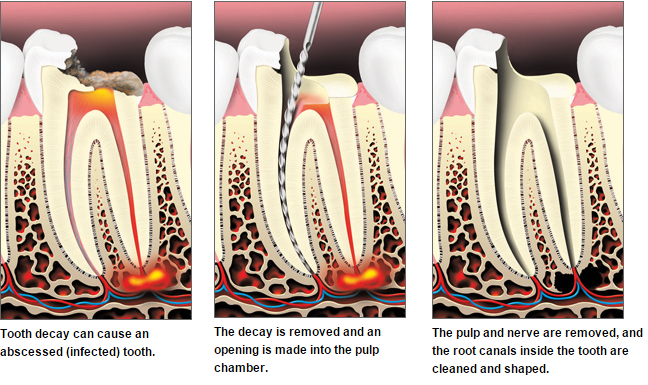

What materials are used for the crown?
Crowns can be made from several materials. The type chosen depends on where the tooth is located in your mouth, the amount of natural tooth left, your preferences and your dentist’s judgment about what is best for you.
How long will the restored tooth last?
A tooth with a root canal filling can last for years. Teeth with root canal fillings can, however, become decayed or fractured, or get gum disease, just like any other teeth. Daily cleaning and regular exams will help you keep your teeth healthy, whether they’ve had root canals or not.

